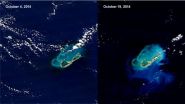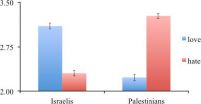(Press-News.org) By analysing DNA extracted from the petrous bones of skulls of ancient Europeans, scientists have identified that these peoples remained intolerant to lactose (natural sugar in the milk of mammals) for 5,000 years after they adopted agricultural practices and 4,000 years after the onset of cheese-making among Central European Neolithic farmers.
The findings published online in the scientific journal Nature Communications (21 Oct) also suggest that major technological transitions in Central Europe between the Neolithic, Bronze Age and Iron Age were also associated with major changes in the genetics of these populations.
For the study, the international team of scientists examined nuclear ancient DNA extracted from thirteen individuals from burials from archaeological sites located in the Great Hungarian Plain, an area known to have been at the crossroads of major cultural transformations that shaped European prehistory. The skeletons sampled date from 5,700 BC (Early Neolithic) to 800 BC (Iron Age).
It took several years of experimentation with different bones of varying density and DNA preservation for the scientists to discover that the inner ear region of the petrous bone in the skull, which is the hardest bone and well protected from damage, is ideal for ancient DNA analysis in humans and any other mammals.
According to Professor Ron Pinhasi from the UCD Earth Institute and UCD School of Archaeology, University College Dublin, the joint senior author on the paper, "the high percentage DNA yield from the petrous bones exceeded those from other bones by up to 183-fold. This gave us anywhere between 12% and almost 90% human DNA in our samples compared to somewhere between 0% and 20% obtained from teeth, fingers and rib bones".
For the first time, these exceptionally high percentage DNA yields from ancient remains made it possible for scientists to systematically analyse a series of skeletons from the same region and check for known genetic markers including lactose intolerance.
"Our findings show progression towards lighter skin pigmentation as hunter and gatherers and non-local farmers intermarried, but surprisingly no presence of increased lactose persistence or tolerance to lactose" adds Professor Pinhasi.
"This means that these ancient Europeans would have had domesticated animals like cows, goats and sheep, but they would not yet have genetically developed a tolerance for drinking large quantities of milk from mammals," he says.
According to Professor Dan Bradley from the Smurfit Institute of Genetics, Trinity College Dublin, co-senior author on the paper, "our results also imply that the great changes in prehistoric technology including the adoption of farming, followed by the first use of the hard metals, bronze and then iron, were each associated with the substantial influx of new people. We can no longer believe these fundamental innovations were simply absorbed by existing populations in a sort of cultural osmosis."
INFORMATION:
WASHINGTON, D.C., October 21, 2014 -- X-ray phase tomography is an imaging technique that uses penetrating X-rays to create volumetric views through "slices" or sections of soft biological tissues, such as tumors, and it offers strongly enhanced contrast compared to conventional CT scans. Yet scientists still do not know which X-ray phase tomography methods are best suited to yield optimized results for a wide variety of conditions.
To answer this question, a large group of researchers in Europe set out to compare three different X-ray phase tomography methods at the ...
WASHINGTON, D.C., October 21, 2014 -- Hikers are generally advised that the weight of the packs they carry should correspond to their own size, with smaller individuals carrying lighter loads. Although petite backpackers might appreciate the excuse to hand off heavier gear to the larger members of the group, it turns out that they may not need the help.
While leading students on extended backpacking trips for Outward Bound, Kansas State University physics professor Michael O'Shea noticed that some of the smaller students could comfortably carry a greater pack weight than ...
VIDEO:
Chapman University has initiated the first comprehensive nationwide study on what strikes fear in Americans in the first of what is a planned annual study. The Chapman Survey on American...
Click here for more information.
ORANGE, Calif. – Chapman University has initiated the first comprehensive nationwide study on what strikes fear in Americans in the first of what is a planned annual study. According to the Chapman poll, the number one fear in America today ...
A team of researchers led by NOAA's Office of National Marine Sanctuaries have discovered two significant vessels from World War II's Battle of the Atlantic. The German U-boat 576 and the freighter Bluefields were found approximately 30 miles off the coast of North Carolina. Lost for more than 70 years, the discovery of the two vessels, in an area known as the Graveyard of the Atlantic, is a rare window into a historic military battle and the underwater battlefield landscape of WWII.
"This is not just the discovery of a single shipwreck," said Joe Hoyt, a NOAA sanctuary ...
NASA's Aqua and Terra satellites captured before and after images of Bermuda and surrounding waters before and after Hurricane Gonzalo struck the island on Oct. 17. The images revealed how Gonzalo stirred up the sediment from the ocean bottom.
The MODIS instrument or Moderate Resolution Imaging Spectroradiometer that flies aboard NASA's Aqua and Terra satellites provided imagery of Bermuda and the stirred sediment. In a comparison of imagery before and after Hurricane Gonzalo passed, the after image showed sediment streaming east and south of Bermuda. The MODIS instrument ...
Slow-moving Tropical Storm Ana was still affecting parts of Hawaii on Oct. 20 when NASA's Aqua satellite passed overhead from its orbit in space. Imagery from Aqua showed that wind shear was affecting the storm.
The Moderate Resolution Imaging Spectroradiometer or MODIS instrument aboard NASA's Aqua satellite captured a visible picture of Tropical Storm Ana over Hawaii on Oct. 20 at 23:55 UTC (7:55 p.m. EDT). The image showed that most of the clouds and showers were north and east of the center of circulation, pushed away from the center by strong southwesterly wind ...
CHAMPAIGN, Ill. — Publicly traded corporations are increasingly publishing social responsibility reports for investors, who now consider such information alongside traditional financial data before investing in a company.
But according to new research from a University of Illinois expert in financial reporting and financial statement analysis, less-numerate investors are more susceptible to style and presentation effects of the reports, potentially leading them to make unintended judgments about the company.
W. Brooke Elliott, a professor of accountancy at Illinois, ...
CHICAGO –A new study in the Journal of Food Science, published by the Institute of Food Technologists (IFT), evaluated consumers' choice in fresh tomato selection and revealed which characteristics make the red fruit most appealing.
The researchers found that the most important fresh tomato attributes were color, amount of juice when sliced and size. Consumers were most drawn to fresh tomatoes shown to be red, firm, medium/small sized, crisp, meaty, and that contain few seeds.
The study also found that a lack of characteristic taste and flavor – including ...
What makes human conflict intractable – and how can psychological research resolve historic disagreements? A new study published in the Proceedings of the National Academy of Sciences by a team of researchers from The New School for Social Research, Northwestern University and Boston College demonstrates how seemingly unsolvable political and ethnic conflicts are fueled by asymmetrical perceptions of opponents' motivations – and that these tensions can be relieved by providing financial incentives to better understand what drives an adversary group.
"This ...
Boulder, CO, USA — Stegosaurs might be portrayed as lumbering plant eaters, but they were lethal fighters when necessary, according to paleontologists who have uncovered new evidence of a casualty of stegosaurian combat. The evidence is a fatal stab wound in the pubis bone of a predatory allosaur. The wound – in the conical shape of a stegosaur tail spike – would have required great dexterity to inflict and shows clear signs of having cut short the allosaur's life.
"A massive infection ate away a baseball-sized sector of the bone," reports Houston Museum ...







